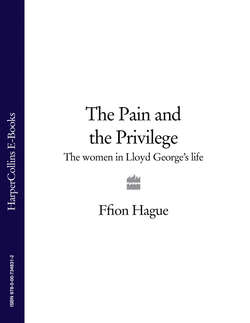The Pain and the Privilege: The Women in Lloyd George’s Life

Реклама. ООО «ЛитРес», ИНН: 7719571260.
Оглавление
Ffion Hague. The Pain and the Privilege: The Women in Lloyd George’s Life
The Pain And The Privilege
Ffion Hague
Table of Contents
INTRODUCTION
1 Hewn from the Rock
2 The Cottage-Bred Man
3 Love’s Infatuated Devotee
4 Maggie Owen
5 Mrs Lloyd George
6 From Wales to Westminster
7 Kitty Edwards
8 Mrs Tim
9 Mair
10 Frances
11 Overloaded with Flattery
12 Love and Libel
13 A Family in Downing Street
14 Secrets and Smokescreens
15 Two Wives at No. 10
16 The Family at War
17 Diverging Paths
18 Disillusionment
19 ‘Dame Margaret is the Star’
20 Alone into the Wilderness
21 Megan
22 New Loves
23 Crises Public and Private
24 Private Sorrows
25 Till Death us do Part
EPILOGUE
NOTES
BIBLIOGRAPHY
INDEX
ACKNOWLEDGEMENTS
About the Author
Copyright
About the Publisher
Отрывок из книги
The Women who Loved Lloyd George
Title Page
.....
Young people in rural Wales were encouraged to meet and mingle in chapel. In this way they could get to know their future spouses under the protective gaze of the chapel elders, avoiding too much intimacy and the social and ideological complications of an inter-denomina-tional marriage. This was not just a means of keeping affairs respectable and young girls out of trouble: interdenominational rivalry ran high, and a cross-chapel marriage was socially troublesome. For nonconformists like Lloyd George and his family, chapel membership was a serious, lifelong commitment. The congregation acted as an extended family and an early form of social services, with each chapel looking after its own sick and elderly and members clubbing together to meet shared expenses. Each chapel had its own ceremony to accept new members and bind them for life, and the Calvinistic Methodists and other denominations took their ‘cwrdd derbyn’ (confirmation service) very seriously indeed. Members were expected to play a part in the chapel community, attend services faithfully and pay a subscription each week to meet expenses. Interdenominational, even same-denomination, inter-chapel rivalry meant that relationships that crossed the boundaries were heavily discouraged.
This caused practical difficulties within the broader community. How could married partners belong to different congregations when membership was, in effect, a subscription to a large family? Husbands and wives would have to inhabit different social circles. In which faith would children be raised, and what about the financial contribution that families were expected to make? They could hardly afford to pay two. It was just not feasible. Admittedly, marrying into a different nonconformist denomination was better than marrying Church, but only just.
.....